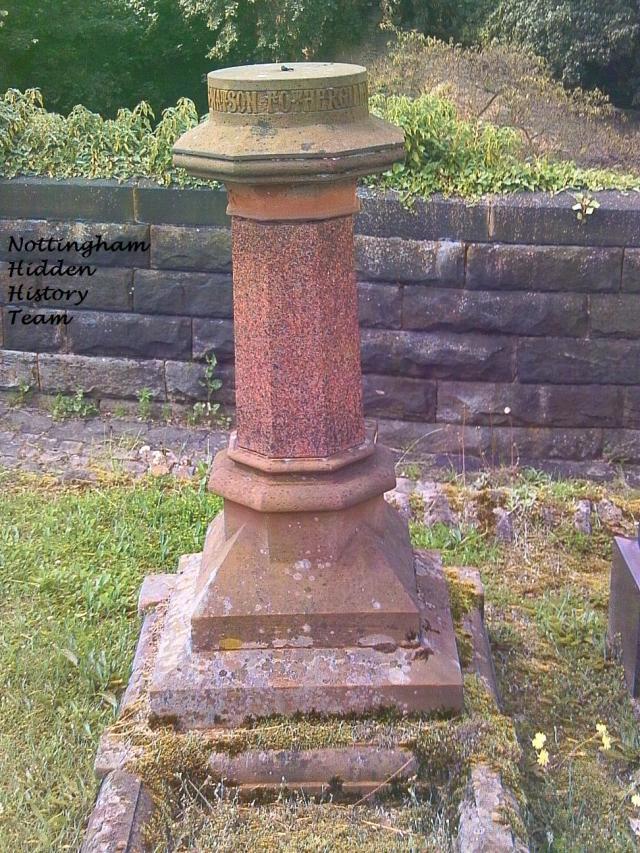Watson Fothergill’s grave in the Church Rock Cemetery faces opposite the big drop of the St Ann’s valley (the pauper’s graves). It is a fitting tribute of a grave to a great man of Nottingham. However many people when seeing the grave for the first time do point out the resemblance of the grave to a bird bath.
Watson Fothergill (12 July 1841 – 6 March 1928) was an English Architect who designed over 100 unique buildings in Nottingham . His influences were mainly from the Gothic Revival and Old English vernacular architecture styles.
His work dates from between the years 1870 to 1912.
Some of the many buildings in Nottingham he designed include:
- Fothergill House, 7 Lenton Road, The Park, Nottingham (1872)
- Castle Bank, 5 Lenton Road, The Park, Nottingham (1873)
- Albert Hall Nottingham (1876) – destroyed by fire in 1906
- Nottingham Daily Express offices (1876)
- Congregational Church (later United Reformed), Westfield Lane, Mansfield (1877) – demolished 1980s
- Cattle Market, Nottingham Road, Mansfield (1877)
- Tower House, 53 Park Row, Nottingham (1880) alterations
- 3 South Road, The Park, Nottingham (1875 – 1881)
- Nottingham and Notts Bank, Thurland Street (1877 – 1882)
- Mortimer House, Castle Road, Nottingham (1883)
- Former Coffee Tavern and Institute, Hucknall (1884)
- Clawson Lodge, 405 Mansfield Road, Nottingham (1884)
- Row of shops 87 – 95 Derby Road, Nottingham (1884)
- 21, 23, 27 and 39 Newcastle Drive, The Park, Nottingham (1886)
- St. Nicholas’ Church Rectory, Maid Marian Way, Nottingham (1886) – demolished 1960
- National Westminster Bank, Cattle Market, Loughborough, Leicestershire (1886)
- Budworth Hall, High Street, Ongar, Epping Forest, Essex (1886)
- Black Boy Hotel, Nottingham (1887) – demolished 1970
- Nottingham and Notts Bank, Kirk Gate, Newark on Trent (1887)
- 409 and 411 Mansfield Road, Nottingham (1887)
- 62 – 64 Castle Boulevard, Nottingham (1888)
- 3 and 4 Huntingdon Drive, Nottingham (1888 – 1889)
- 2-8 and 5-13 Hope Drive, Nottingham (1888 – 1889)
- Halifax Building Society, 24 Market Place, Long Eaton, Derbyshire (1889)
- Milbie House, Pilcher Gate, Nottingham (1889)
- Elberton House, 9 Hardwick Road, Nottingham (1889-1890)
- 14 Mapperley Road, Nottingham (1890) (additions to a mid 19th century house)
- Emmanuel Church, Woodborough Road (1883 – 1892) – demolished 1972
- Norris Ladies Homes, Berridge Road, Nottingham (1892)
- Coach House at Kingswood, Bulcote (1893)
- Kingswood House, Bulcote (1893)
- St. Andrew’s House, Mansfield Road/Mapperley Road, Nottingham (1893)
- 208 Mansfield Road, Nottingham (1893)
- Cleave House, 1 and 3 Sherwood Rise, Nottingham (1893)
- Simon and Pickard Warehouse, Castle Boulevard, Nottingham (1894)
- Baptist Chape, Woodborough Road, Nottingham (1893 – 1894)
- Jessops Drapery Store, 14-30 King Street, Nottingham, (1895)
- 62 and 64 Castle Boulevard, Nottingham (1895)
- Furley and Co, Lower Parliament Street/Clinton Street, Nottingham (1896) – now LloydsTSB
- Cuckson, Hazeldine and Manderfield Warehouse, Barker Gate, Nottingham (1897)
- Queens Chambers, Queens Street/Long Row, Nottingham (1897)
- Lambley Almshouses, Woodborough Road, Nottingham (1897)
- The Yorker Public House, Mansfield Road, Nottingham (1898) – now The Rose of England
- 9 High Pavement, Nottingham (1898)
- Carlton Laundry, Marhill Road, Carlton (1899)
- Burlington Tower, Burlington Road, Nottingham (1899)
- Nottingham and Notts Bank, 111 Carrington Street, Nottingham (1900) – now vhs Fletchers solicitors
- 65-71 Foxhall Road, Nottingham (1901)
- 75-95, Foxhall Road, Nottingham (1901)
- Beechwood, 30A Mapperley Road, Nottingham (1904)
- 413-419 Mansfield Road, Nottingham (1906)
For further information on Watson Fothergill please see link below:


